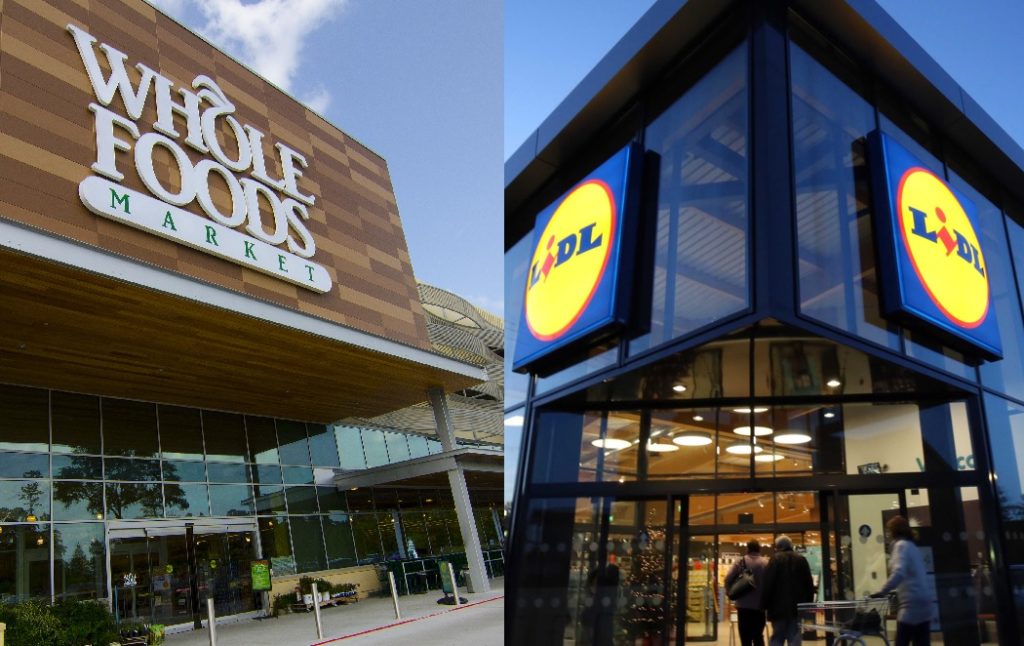
It was last year at this time that the U.S. grocery industry was revolutionized. Twice.
One year later, has any of it changed the way you shop?
The small-format grocer Lidl opened its first U.S. stores exactly one year ago, June 15th, 2017. And a day later, Amazon surprised the industry by announcing its purchase of Whole Foods Market. Lidl was expected to threaten traditional grocers with its curated selection and low prices, while Amazon was expected to change the way we shop in stores while jump-starting the move toward buying more of our groceries online.
And how are those efforts going? Neither Lidl nor the Amazon-Whole Foods combination can be said to be failures, to be sure. But at the same time, neither has quite revolutionized the industry. At least not yet.
Lidl already operated some 10,000 stores in 27 European countries when it opened its first batch of ten stores in North Carolina, South Carolina and Virginia last year. With smaller stores and a limited selection of mostly store-brand products, Lidl is often thought of as a somewhat bigger, brighter ALDI, though the company aimed even higher upon its U.S. launch, calling itself “a hybrid similar to Trader Joe’s or Harris Teeter”.
And many shoppers tended to agree, as early reviews were mostly positive. So Lidl planned as many as 100 new store openings all up and down the East Coast, from Georgia to Pennsylvania, with forays further West beginning in year two.
Instead, its expansion has stalled out at 53 locations. Aside from a single outpost in Georgia, one in Delaware and one in New Jersey, Lidl’s footprint remains restricted to North Carolina, South Carolina and Virginia. New stores are opening at a rate of only one per month so far this year, with the last store opening back on May 24th, and there have been no further announcements of upcoming new store openings just yet. On the contrary, Lidl has been sued at least twice by developers in Texas and North Carolina, who accuse the company of backing out of deals to build new stores there.
One might be tempted, then, to consider Lidl a flop in the making. The company’s own CEO called the U.S. launch a “catastrophe”, after all.
But a new report gives Lidl a glowing review. Consulting firm Oliver Wyman conducted a survey to mark Lidl’s first year, and found that “Lidl is succeeding in unexpected ways with U.S. consumers”. Those consumers are “shopping at Lidl more frequently. They are spending more there. And they are very satisfied,” the report found.
The report deduces that Americans are not as averse to a limited product selection, nor as loyal to brand names, as commonly thought. “Lidl is effectively tapping into American consumers’ changing tastes and preferences,” the report concludes, highlighting “the latent consumer demand for a value-for-money, less-is-more format” which is “making it harder for incumbent grocers to compete”.
So why isn’t Lidl already wildly successful then? The report, along with many Lidl shoppers and even the company itself, agree it’s all about location. “Difficulty in reaching stores is cited as the number-one reason for not shopping more often at Lidl,” the Oliver Wyman report reads. A magazine report earlier this year faulted Lidl’s U.S. advance team for locating stores in out-of-the-way spots, while their Germany-based bosses were “content to look at locations on Google Maps” before approving the sites.
So Lidl’s slowing pace of new store openings may turn out to be a temporary lull – it’s been taking the time to identify better locations in more populated areas, so until those stores start opening, it may be too soon to write Lidl off.
Meanwhile, there are already plenty of Whole Foods Markets in populated areas, all over the country. But to hear some retail analysts talk about it, store locations wouldn’t even matter by now, because Amazon’s ownership would mean we’d all be sitting at home, ordering Whole Foods products and having them delivered to our door.
That’s possible, of course, but ordering groceries from Whole Foods for home delivery isn’t any more commonplace than ordering from anywhere else at this point. Other retail analysts looked at what Amazon has been doing with its cashierless “Amazon Go” stores, and figured that technology would be coming to Whole Foods as well. But that hasn’t happened either.
Amazon got a lot of publicity for lowering prices of many popular Whole Foods items, but that hasn’t changed the fact that Whole Foods is still a pricey place. And while Amazon did fulfill its promise of replacing Whole Foods’ loyalty program with Amazon Prime, so far the perks are relatively modest – Prime members get access to some special sale prices, and get a nice but not mind-blowing additional 10% off promoted items.
For shoppers, then, going to Whole Foods isn’t all that much different than it was a year ago. Lest anyone forget, Whole Foods was struggling when Amazon bought it, and not even new owners have been able to turn it into an overnight success story just yet.
So when it comes to these transformative grocery developments one year ago, it’s more about what’s still to come than what’s happened so far. Lidl and Whole Foods still have a lot of promise and potential. But ultimately, whether it takes one year, or ten – it will be up to shoppers to decide whether these retailers will turn out to be as successful and revolutionary as they hope they will be.
Image sources: Whole Foods / Lidl










